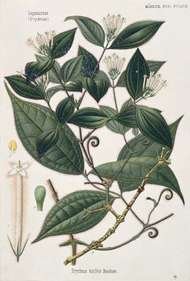For centuries, hunters of the native tribes of South America used blow darts tipped with a paralytic agent to capture their prey. The poison on the tips of the darts wouldn't kill their targets. It simply immobilized them for a long enough time to be captured or killed. This poison, known as tubocurarine, or Curare, was extracted from the climbing vine, Chondrodendron tomentosum pictured here.

In the time of the exploration of the new world, English physicians who interacted with these native South Americans realized that there could be some possible use of this drug as an anesthesthetic for surgeries. Physicians noticed that animals under the influence of Curare would be completely imobilized, but would make a full recovery after being temporarily paralyzed. According to these physicians, the discovery of tubocurarine would be revolutionary for the anesthitizing of surgery patients. They were so confident in their discovery, that one of the physicians volunteered to undergo a surgy under its influence in order to demonstrate its effectiveness. Unfortunately for him, what they failed to realize was that tubocurarine was effective as a paralyzing agent, but had no effect whatsoever to block nociceptors, sensory receptors throughout the body that receive pain signals. He felt every cut the surgeon made as if he were completely awake, except he could not move, speak, nor do anything about it.
Curare paralyzes by preventing the neurotransmitter acetylcholine from engaging its receptors at nueromuscular juntions. This in turn prevents any propagation of nerve signals to all voluntary muscles of the body, while leaving receptors of every other kind completely functional.
It is now used in anesthesia for the purpose of temporary paralysis, along with the necessary pain blockers.
Sources:
Kaplan. MCAT: Biology Review. Kaplan Publishing. 2016. New York. Print.
https://en.m.wikipedia.org/wiki/Tubocurarine_chloride Retrieved on May 23, 2018.
Image source:
Hi @nhahn93. Nice article. When I first start out, I was about to choose curare as my username but I went ahead with chloroform instead. There are some suggestions I would like to make:
If you have any problem regarding STEM-related articles, you can join steemSTEM Discord Channel and we will be glad to assist you.
Both of those names are pretty clever! Thank you for the tips! I'll be sure to make corrections!
Nice article @nhahn93! Any particular reason the subject interested you?
Thanks! I like the science behind it and how different compounds effect the body in such specific ways :)